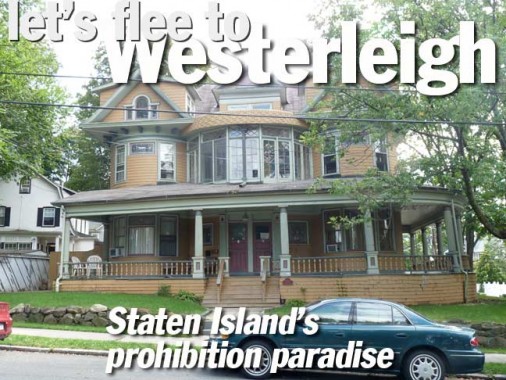In central Staten Island there’s a place whose original residents were dedicated to stamping out demon liquor years before the Volstead Act actually did the deed from 1919 to 1933. Developed in 1887 by the National Prohibition Campground Association, what’s now Westerleigh was known as Prohibition Park and was lined with narrow, brick streets and one-family houses, some of them in ornate Victorian style.
Most of the streets in Westerleigh are named for Presidential /Vice Presidential candidates of the Prohibition Party (like Clinton B. Fisk) or “dry” states such as Maine, Ohio, and Virginia. The correct spelling is Fiske.
Neal Dow was a Civil War general on the Union side and, of course, a Prohibitionist. His mansion is a museum and can be found in Portland, Maine.
Waters Avenue has been allowed to keep its brick paving and so still looks like it did decades ago.
In October 2002, much of Westerleigh was being repaved, and this got covered over.
One of the many handsome dwellings along Waters Avenue.
Clinton B. Fisk Avenue
Clinton B. Fisk Avenue
Waters at Demorest
Clinton B. Fisk Avenue
Neal Dow near Waters Avenue, above and below
The Boulevard was conceived and laid out as Prohibition Park’s main drag. Just because there was no liquor didn’t mean its residents couldn’t enjoy the finer things in life. This house, at 42, was built in 1893 for Frank Burt.
At 6 and 8 The Boulevard a solarium adds a modern touch. This also was built in 1893, for Isaac Funk.
Westerleigh Park, between Maine and Springfield, Neal Dow and Willard, is all that remains of Prohibition Park’s original expansive green space, where band concerts and lemonade and, of course, stemwinders opposing the demon rum were the rule. Willoughby…next stop, Willoughby!
One house in Westerleigh predates even the prohibitionists.This house was buiult between 1730 and 1760 for Peter Housman, who was, by the way, a Tory during the Revolution. Presumably, he moved after the war was over. The house is catercorner to the street grid that was imposed by the creators of Prohibition Park in the 1880s.
The small stone unit on the right is the oldest part of the house.
Westerleigh is also home to some interesting modern architecture. The Society of St. Paul Seminary was built in 1969. Its windows slant outward from the top. In winter, without the foliage, it makes an impressive sight due to its height.
This red and white Art Moderne building, just across Ingram Avenue from the seminary, hosts a group of eye doctors.
6/12/2000





